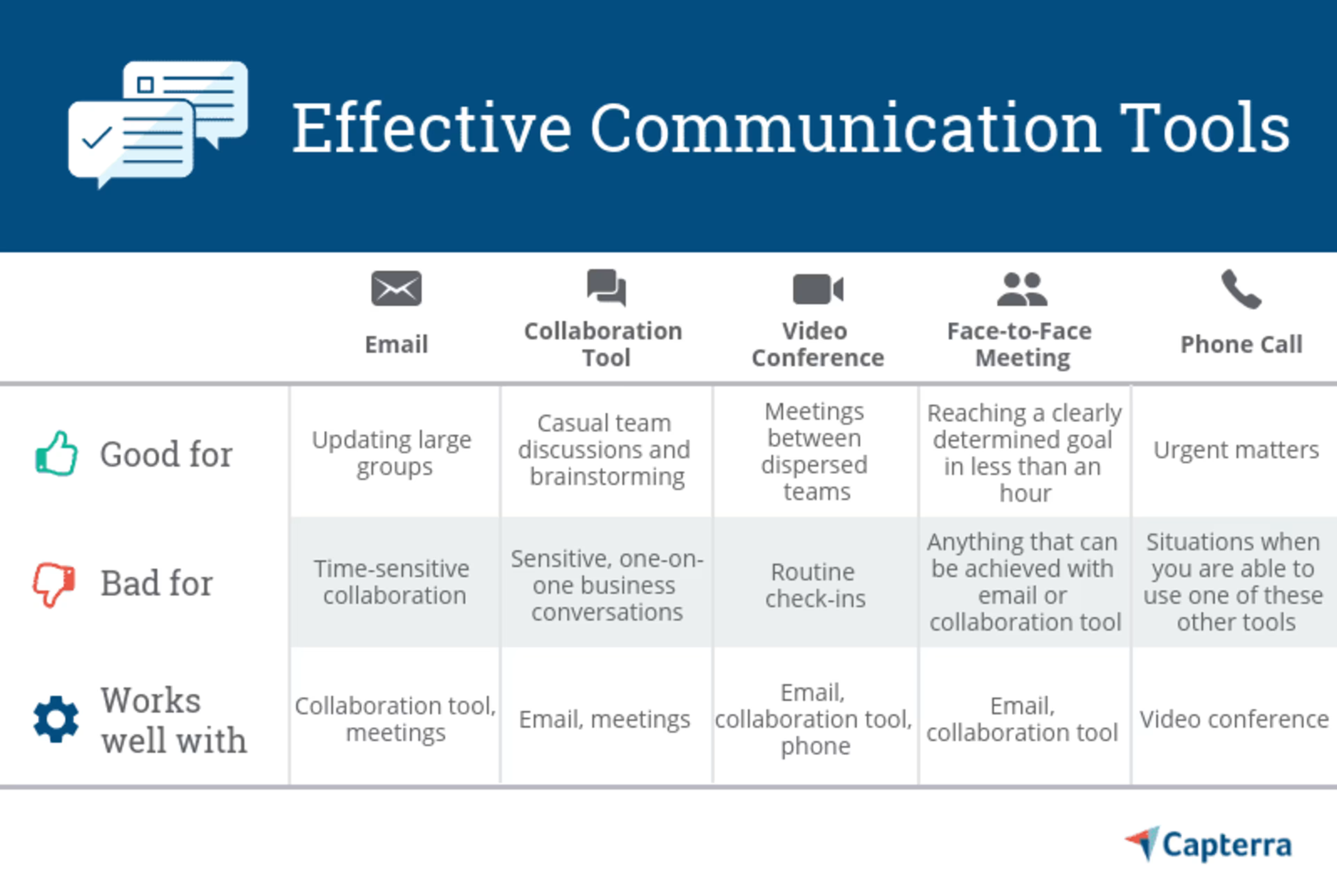In the project management community, we love to use the term Agile.
If you're Agile, you are flexible, versatile, adaptable, innovative.
Why, then, are we so rigid when it comes to the methods we use for project management communication?
Waterfall project management uses heavy documentation and lots of email, while Agile utilizes quick, face-to-face meetings and collaboration tools. Even within Agile, the Scrum framework uses another variation on the face-to-face meeting: the stand-up meeting, or daily scrum.
But whichever project management style you subscribe to, it's important to choose the most effective communication tool for every unique project, because effective communication has a massive impact on the success of your projects.

Consider the following.
According to a Gartner webinar (free with business email registration), enterprises that effectively communicate:
Have a 19% higher market premium
Experience 57% higher shareholder returns
Are 4.5 times more likely to report high levels of employee engagement
Are 20% more likely to report lower turnover
With so much at stake, it's more important to use the most effective communication tools for each situation than trying to adhere to an overarching project management style.
By borrowing the best communication tools from different project management styles, small business leaders can develop a communication plan that is more effective than any one part of the whole.
The right mix of effective communication tools
Modern project management tells us that Waterfall is inferior because it relies so heavily on documentation. But why can't we use documentation in small doses when it makes sense, like when we have a longstanding, proven process, in addition to our daily standup meetings?
And even if you are the most Agile team around, there are still situations that call for the e-word, like when you need to quickly make a one-time announcement to a dispersed group.
Communicating in 2019 is much more complicated than it was in 1989, when you basically had to decide between a phone call, fax, or a handwritten letter. Now more than ever, different situations warrant different types of communication.

How to choose the right communication channel
“If there has been a senior leadership change, for example, it can be all too easy to think, 'I'll just write a quick post on the intranet,'" says Iliyana Hadjistoyanova, senior research analyst at Gartner. “Instead, comms should be asking, 'How do I make sure employees are informed in the right way and feel equipped to deal with this leadership change?'"
In this case, that approach might involve sending out a company-wide email, making a post on the company intranet, and hosting a video conference among the team leaders.
What if you could pick and choose the most effective communication tools from different schools of thought to communicate the most effectively with your teams?
You can, and here's how.
In the next five sections, we'll look at five primary forms of communication: email, collaboration tools, video conferencing, face-to-face meetings, and phone—sorry, fax users. We'll look at when each of them is best used and when to avoid each, to give you a guide for a wide spectrum of project management communication situations.
1. Email for updating large groups and sending files
When to use it:
Updating large groups on an issue that affects everyone in the organization but does not require a specific response.
Driving recipients to more appropriate communication channels via invitations and calendar events.
Delivering documents to parties who are not already part of your file-sharing tool.
When not to use it:
When you need a timely response from the recipient.
When you need to discuss a sensitive issue with the recipient such as a performance review or staff turnover event.
When your communication calls for extensive follow-up conversation.
The key to using email for project management communication is to make sure you're not leaving room for misinterpretation or treating a sensitive subject callously. For example, imagine how you would feel if someone you had been working directly with for five years announced they were leaving in an email.
It's also important to be considerate of email clutter. If you have the option of starting a discussion between six people with a quick stand-up meeting or instant messages versus initiating an email thread that will inevitably expand to dozens of messages, for everyone's sanity, please choose the former.
What it works well with: An email's effectiveness can be boosted when it is followed up with a video or intranet blog post to clarify and expand on what was announced in the email. For example: The CEO of the company is retiring or you're revamping the company's health care plan, so you send out a mass email making the announcement, then follow it up with a town hall video conference.
2. Collaboration tools for unstructured back-and-forth
When to use it:
Casual discussion within your team.
Requests for shared information such as reference documents or meeting times.
Digital brainstorming that does not require immediate action.
When not to use it:
Discussing sensitive information such as performance or compensation.
One-on-one conversations on public channels.
Brainstorms that call for extensive collaboration between participants.
Web 2.0-era collaboration tools have been a godsend for Agile project management teams around the world. Discussions that used to result in a maddening trail of emails can now be handled in an elegant conversation that is searchable when you need it but fades harmlessly into the background when you don't.
Collaboration tools can also save you from excessive meetings. For example: Get quick, routine status updates from your team on Monday morning instead of dragging everyone into a conference room for 30 minutes.
What it works well with: When an email chain becomes unwieldy and veers away from the original topic, be a project ninja and steer it over to your collaboration channel. You can also continue a conversation that starts in a video conference or in-person meeting in your collaboration tool rather than sending the meeting off on a tangent.
3. Video conference for face-to-face with dispersed teams
When to use it:
Planning discussions between dispersed decision-makers.
Sensitive one-on-ones between managers and direct reports when travel would be cost prohibitive.
Brainstorming between dispersed collaborators on a time-sensitive project.
When not to use it:
When you just need to check in with an individual or small group.
When you're delivering information that does not require follow-up.
When you have one or two specific questions for a collaborator.
Video conferencing (which has actually been around since the 1960s but wasn't really practical until 50 years later) is ideal for situations that would normally call for a face-to-face meeting but that travel makes cost prohibitive. For example: discussing an annual performance review or promotion with a direct report in another location.
Most video conferencing tools also include a screen-sharing feature, making it an ideal tool for introducing a team to a new project management tool, for example. Pro tip: Practice using your video conferencing tool ahead of time so you don't have to spend the first 15 minutes of your meeting struggling to set it up.
What it works well with: Say you're having a routine chat with a colleague on your team collaboration tool. In the course of the conversation, you run into a feature in one of your project management tools that your colleague is having difficulty with or you begin discussing a conflict in your quarterly planning spreadsheet. This is an ideal scenario to kick the text chat over to a video conference so that you can explain things in-depth and share your screen.
4. Face-to-face/standup meetings for quick roundtables
When to use it:
When you have multiple team members together in the same location and a situation that would otherwise call for a video conference (see above).
When you have a clear goal in mind that can be achieved in less than an hour by meeting face-to-face with other decision-makers.
When you're discussing a sensitive business matter with an on-site colleague.
When not to use it:
When some critical decision-makers are not able to physically attend. (In this case, you should consider a hybrid in-person meeting for those on location combined with video conference for remote stakeholders.)
When you do not have a concrete objective for the meeting. For example, you don't need to have a meeting just to "catch up."
When the objective of the meeting could be met through more efficient methods, such as an email or collaboration tool.
Face-To-Face conversation is the ultimate form of communication. However, it is far from the most efficient form of communication, and in project management, efficiency matters.
Face-to-face meetings are always preferable to the alternatives when the situation calls for it and when you have the time, but make sure you ask yourself these five questions before scheduling any face-to-face meetings.
What it works well with: Using email to disperse important documentation or presentation slides before getting together for a face-to-face meeting is a great way of helping the meeting run as efficiently as possible. A collaboration tool also works well to provide quick follow-up information on an issue that comes up during a meeting.
5. Phone calls for urgent matters and conference calls
When to use it:
When there is an urgent matter, such as a meeting cancellation less than an hour before the scheduled time.
When you need to get a dispersed group together for a live conversation, and not everyone has the internet connection or technology to support a video conference.
When you're having a conversation with a stakeholder who has told you that they prefer phone calls to other forms of communication.
When not to use it:
On weekends, holidays, or after hours unless there is a real emergency.
When you can send an email or instant message instead.
When you have the option of a video conference instead. Video conferencing offers the added benefit of visual cues and screen sharing.
Ahh, the phone. It may seem outdated, but when you think about it, the most advanced iteration of this technology—the mighty smartphone—is actually a handheld hub for four of the five communication tools on this list.
But when do you use its different features? The key is to know your team. If a contributor always responds to instant messages quickly and has the team collaboration tool on their smartphone, why distract them with an invasive phone call?
But here's another scenario: You have an important meeting with a vendor coming up in three hours and you need to reschedule. You send them an email but get no confirmation for two hours. Now is the time for the tried-and-true phone call to come out to shine.
What it works well with: Most up-to-date web conferencing software allows participants to join the conference from their computer as a video caller, or from their phone via dialing in. In this way, you can combine a video conference and a phone conference, allowing the added benefits of the former without excluding those who are away from their computers or in an area with spotty internet connection.
What's on your menu of effective communication tools?
As a project manager, you should be confident using all of the different communication tools in your toolbox. I have tried to list some of the more common scenarios above when each makes the most sense and when they work best together, but the possibilities are limitless.
What's your favorite recipe for effective communication? Video conference with a sprinkle of instant message? Email with a dash of good old fashioned phone call? And what are some situations when you would never use one or more of the tools listed above? Let me know in the comments, or communicate with me on Twitter at @Andrew JosConrad.
Here are a few articles on project management communication to continue your reading: